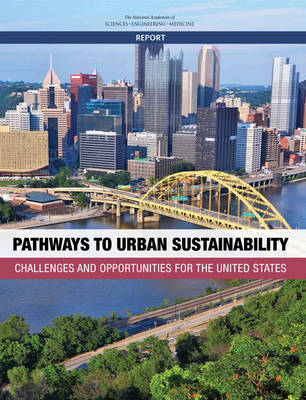
Pathways to Urban Sustainability
Challenges and Opportunities for the United States
Seiten
2016
National Academies Press (Verlag)
978-0-309-44453-8 (ISBN)
National Academies Press (Verlag)
978-0-309-44453-8 (ISBN)
Cities have experienced an unprecedented rate of growth in the last decade. More than half the world's population lives in urban areas, with the U.S. percentage at 80 percent. Cities have captured more than 80 percent of the globe's economic activity and offered social mobility and economic prosperity to millions by clustering creative, innovative, and educated individuals and organizations. Clustering populations, however, can compound both positive and negative conditions, with many modern urban areas experiencing growing inequality, debility, and environmental degradation.
The spread and continued growth of urban areas presents a number of concerns for a sustainable future, particularly if cities cannot adequately address the rise of poverty, hunger, resource consumption, and biodiversity loss in their borders. Intended as a comparative illustration of the types of urban sustainability pathways and subsequent lessons learned existing in urban areas, this study examines specific examples that cut across geographies and scales and that feature a range of urban sustainability challenges and opportunities for collaborative learning across metropolitan regions. It focuses on nine cities across the United States and Canada (Los Angeles, CA, New York City, NY, Philadelphia, PA, Pittsburgh, PA, Grand Rapids, MI, Flint, MI, Cedar Rapids, IA, Chattanooga, TN, and Vancouver, Canada), chosen to represent a variety of metropolitan regions, with consideration given to city size, proximity to coastal and other waterways, susceptibility to hazards, primary industry, and several other factors.
Table of Contents
Front Matter
Summary
1 Introduction
2 Urban Sustainability Indicators and Metrics
3 Principles of Urban Sustainability: A Roadmap for Decision Making
4 City Profiles
5 A Path Forward: Findings and Recommendations
References
Appendix A: Committee on Pathways to Urban Sustainability: Challenges and Opportunities Biographical Information
Appendix B: Details for Urban Sustainability Indicators
Appendix C: Constraints on the Sustainability of Urban Areas
The spread and continued growth of urban areas presents a number of concerns for a sustainable future, particularly if cities cannot adequately address the rise of poverty, hunger, resource consumption, and biodiversity loss in their borders. Intended as a comparative illustration of the types of urban sustainability pathways and subsequent lessons learned existing in urban areas, this study examines specific examples that cut across geographies and scales and that feature a range of urban sustainability challenges and opportunities for collaborative learning across metropolitan regions. It focuses on nine cities across the United States and Canada (Los Angeles, CA, New York City, NY, Philadelphia, PA, Pittsburgh, PA, Grand Rapids, MI, Flint, MI, Cedar Rapids, IA, Chattanooga, TN, and Vancouver, Canada), chosen to represent a variety of metropolitan regions, with consideration given to city size, proximity to coastal and other waterways, susceptibility to hazards, primary industry, and several other factors.
Table of Contents
Front Matter
Summary
1 Introduction
2 Urban Sustainability Indicators and Metrics
3 Principles of Urban Sustainability: A Roadmap for Decision Making
4 City Profiles
5 A Path Forward: Findings and Recommendations
References
Appendix A: Committee on Pathways to Urban Sustainability: Challenges and Opportunities Biographical Information
Appendix B: Details for Urban Sustainability Indicators
Appendix C: Constraints on the Sustainability of Urban Areas
1 Front Matter; 2 Summary; 3 1 Introduction; 4 2 Urban Sustainability Indicators and Metrics; 5 3 Principles of Urban Sustainability: A Roadmap for Decision Making; 6 4 City Profiles; 7 5 A Path Forward: Findings and Recommendations; 8 References; 9 Appendix A: Committee on Pathways to Urban Sustainability: Challenges and Opportunities Biographical Information; 10 Appendix B: Details for Urban Sustainability Indicators; 11 Appendix C: Constraints on the Sustainability of Urban Areas
| Erscheinungsdatum | 23.11.2016 |
|---|---|
| Verlagsort | Washington |
| Sprache | englisch |
| Maße | 216 x 279 mm |
| Themenwelt | Naturwissenschaften ► Biologie ► Ökologie / Naturschutz |
| Naturwissenschaften ► Geowissenschaften ► Meteorologie / Klimatologie | |
| Sozialwissenschaften ► Soziologie | |
| Weitere Fachgebiete ► Land- / Forstwirtschaft / Fischerei | |
| ISBN-10 | 0-309-44453-5 / 0309444535 |
| ISBN-13 | 978-0-309-44453-8 / 9780309444538 |
| Zustand | Neuware |
| Haben Sie eine Frage zum Produkt? |
Mehr entdecken
aus dem Bereich
aus dem Bereich


